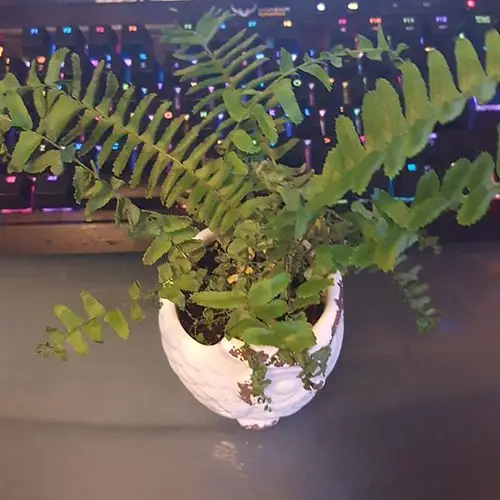A Comprehensive Guide to Watering Your Indoor Boston Fern
Boston ferns are a quintessential indoor plant that evokes images of lush, green fronds spilling over hanging baskets in sun-dappled living rooms. As a houseplant enthusiast, understanding the science and art of watering your fern is key to keeping it thriving. In this comprehensive guide tailored to home gardeners, we will explore the intricacies of watering this delicate plant, ensuring you can nurture your Boston fern to be the envy of any indoor oasis.

Introduction: The Art of Watering Your Green Companion
Watering is a foundational aspect of plant care, yet it’s often the most misunderstood. This fundamental practice is essential to maintaining the vigor and health of your indoor Boston fern. Neglected or overzealous watering can quickly lead to issues like root rot or dehydration, leaving your fern looking less than its best.
Understanding how to provide the right amount of hydration is paramount, and we’ll start by outlining the specific needs of the Boston fern and how to identify signs that it may be thirsty or getting too much of a good thing.
Understanding Your Boston Fern
Characteristics of the Boston Fern
A popular choice for its graceful appearance, the Boston fern (Nephrolepis exaltata) boasts a native habitat of tropical regions and, as such, favors moist environments. Its delicate, lace-like fronds give it a feathery, full look that makes a striking addition to any room.
Watering Needs Specific to Boston Ferns
Unlike many household plants that can tolerate dry conditions, Boston ferns need consistent moisture but avoid waterlogging. They thrive with evenly moist soil that’s allowed to partially dry between waterings. Achieving this balance is crucial to their well-being.

Signs of Overwatering and Underwatering
Visual Cues
Overwatering: If the fern’s soil is consistently wet, it can lead to yellowing or drooping fronds, as well as the onset of mold or fungus.
Underwatering: On the other hand, dry, brittle fronds signal a lack of water, accompanied by slow, weak growth and potentially the shriveling of the plant due to dehydration.
How to Address Each Issue
For an overwatered fern, the first step is to allow the soil to dry out completely before the next watering. You may need to repot the fern if the roots have been damaged by the excess moisture. In the case of underwatering, a thorough soaking can revive the fern, but be sure to address any yellowing fronds through regular hydration and appropriate light exposure.
Watering Techniques for a Happy Fern
Frequency and Amount of Water
Consistency is key when it comes to watering your Boston ferns. They typically require water when the top inch of soil feels dry to the touch. Water the plant until moisture begins to seep out of the bottom, ensuring the roots receive adequate hydration.
Best Practices for Watering Boston Ferns
- Use room temperature water to avoid shocking the plant.
- If your tap water is hard, consider using filtered water to prevent mineral build-up, which can damage the fern over time.
- Misting the fronds can imitate the humid conditions the ferns love but should not replace watering the soil.

Humidity Considerations for Boston Ferns
Importance of Humidity
High humidity is as crucial to Boston ferns as regular watering. 40-50% humidity level is their sweet spot, which can be a challenge to maintain within the typical home environment.
Tips on Maintaining Proper Humidity Levels
- Group ferns with other plants to create a microclimate with higher moisture content.
- Place a humidity tray filled with water and gravel near the fern to increase moisture in the air around it.
- A room humidifier can be a valuable investment for multiple indoor plants, including your Boston fern.
Seasonal Variations in Watering
Boston ferns, like many indoor plants, have different needs depending on the time of year.
Adjusting Watering Schedules Based on Seasons
- Summer: You may need to water your fern more frequently during the hotter months, but ensure good drainage to prevent the roots from sitting in water.
- Winter: With reduced light and lower temperatures, your Boston fern’s growth will slow, so it will need less water. Be vigilant about overwatering during this time.
Troubleshooting Watering Issues
Common Problems and Solutions
- Brown leaf tips are often a sign of dry air, which you can remedy with the humidity-increasing suggestions from earlier.
- Wilting fronds can be a result of either over or under-watering, so it’s essential to reassess your watering practices.
- If your fern is dropping leaves, check soil moisture and light conditions. Inconsistent watering and low light can both lead to leaf drop.
When to Seek Professional Help
If you’ve tried adjusting your watering practices and the health of your fern continues to deteriorate, professional guidance from a horticulturist or reputable plant care service may be necessary to diagnose and treat any underlying issues.
Conclusion: Nurturing Your Boston Fern with Precision
By now, you should feel equipped to care for your Boston fern with finesse. Remember, every plant is unique, and it’s a learning process to understand the subtleties of their preferences. With thoughtful observation and a little botanical intuition, you can master the art of watering and watch as your Boston fern flourishes, adding life and tranquility to your living space.






